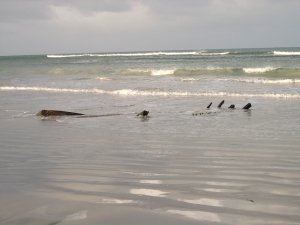By Safwan Jalil (MMA student)
This is about the Maritime Archaeology Field School on Port MacDonnell, South Australia from 3 to 11 July. This is my first time ever doing an archaeological field school in Australia. The field school was supervised by two Flinders University staff: Wendy Van Duivenvoorde and Jennifer McKinnon. Twelve students were in this field school altogether, some doing it as volunteers while others doing it as a class subject.

The Unknown Shipwreck
Port MacDonnell is located about 30km away from Mt Gambier. It is a fishing town that once was a thriving port in 1860s. The name, MacDonnell, comes from Sir Richard Graves MacDonnell, the Governor of South Australia from
1855-1862. Today Port MacDonnell is famous for its lobsters.
The main objective of the field school was to record the Port Macdonnell Jetty and also to identify an unknown shipwreck on the beach, just about 5 minutes
walking distance from where we were staying. We were split into two teams, Shipwreck and Infrastructure team. Jennifer McKinnon supervised the shipwreck team, and Wendy Van Duivenvoorde supervised the Infrastructure team. Each team consisted of six people. Of course, the people in the team were switched daily to give us the feel and experience of different sites everyday.
The shipwreck was first researched in 2006 but no confirmed identification of the shipwreck was made. This was due to time constraints and the lack of permits to take any samples at that time. There are many assumptions about shipwreck it is; some says it is the Bandicoot while others believe it is Countess.
So we, the 2011 group, tried to solve this mystery. We were armed with many different types of equipment necessary to investigate the site, from a simple tape measure to a dumpy level. One thing, however, really holding us back was Mother Nature. Almost, the entire time we were there, the weather was not that friendly. High tide, rain, strong winds and it even hailed at some points. Even with these conditions, we all kept on going.
For the shipwreck investigation, the high tides seemed to be the most problematic. At first we tried to excavate, but the tide just kept pushing. And this with about a dozen sandbags in place. So, we went probing instead. This is to know the approximate dimensions of the shipwreck. This is useful because we could make a comparison of the shipwreck dimensions with the historical ship
database. Apart from that, we also got some wood samples from the wreck, recorded DGPS points and mapped what was visible at that time.
Usually, at some point of the day the shipwreck would be inaccessible. With this, we took the opportunity to do other archaeological research. What we did was anchor recording. We recorded anchors using the “Big Anchor Project” sheet and then upload the data on their website. We managed to get four anchors recorded. Apart from that, our shipwreck assistant supervisor was conducting interviews with the towns people as part of her research.
As for the Port MacDonnell Jetty, the weather was tolerable there in comparison to the shipwreck . This was because of the breakwater nearby that buffered the waves. However, this was no easy feat trying to record about 300 meters of the jetty that had about 193 pylons. It also has a track on it, which was used to transport goods using carriages and a crane. We recorded it by taking points on features on the jetty, mostly bolts and holes. While doing this, we managed to identified the sections that have been repaired, modernized and those that still remained original.

Student gathering courage to go under the jetty
Many methods were used to record the jetty. We used DGPS equipment to record the pylons. DGPS is adifferential global position system courtesy of Amer Khan, the state’s Maritime Heritage Officer. It is bulkier but it is more accurate than some handheld GPSs. We also collected historical records of the jetty from the local library and museum. This was to understand its history and making a rough timeline for the jetty.
Apart from researching the main sites, some of us were also assigned to do a bit of “side quests” every now and then. There were some us doing a historical photography comparison. We took photographs trying to match the same angle as those photos we found in the library’s historic archive. This was to identify the changes that happened around town and also to give a physical overview of the town. For example, a blacksmith shop “S.Milstead & Sons” dated to 1869 is still standing while some of the structures around it have changed.
As for visits during the field school, we managed to get around to many historic places. On our first day, we went to Camel Rock where an old light house once stood. We also went to two museums. One is the Port MacDonnell Maritime Museum and the other is a person’s personal museum. Some of us also went to Dingley Dell Park where we found and record a canon (originally from Cape Banks) and to the cemetery to visit the graves of the peoples involved in a wreck accident around Port MacDonnell.
Overall, the one-week field school was a wonderful experience. So, thanks to all the people who were involved in this field school. There is, however, research still going on involving the wood samples. With the wood samples taken, it is possible to identify the unknown shipwreck (or at least narrow down the suspects). This is found by knowing the timbers’ origin. Since Port MacDonnell was a trading area at some point, there were many different types of ships coming in from around the world. So, with this, it will hopefully solve the identity of the unknown shipwreck.

